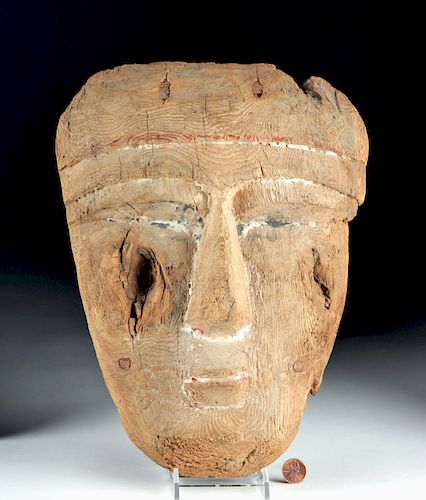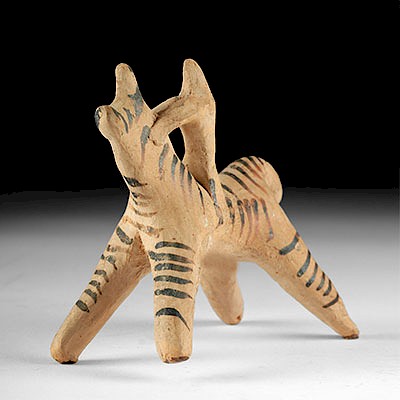Large Egyptian Wood / Gesso Sarcophagus Mask
Lot 8
About Seller
Artemis Fine Arts
686 S Taylor Ave, Ste 106
Louisville, CO 80027
United States
Selling antiquities, ancient and ethnographic art online since 1993, Artemis Gallery specializes in Classical Antiquities (Egyptian, Greek, Roman, Near Eastern), Asian, Pre-Columbian, African / Tribal / Oceanographic art. Our extensive inventory includes pottery, stone, metal, wood, glass and textil...Read more
Estimate:
$1,200 - $1,800
Absentee vs Live bid
Two ways to bid:
- Leave a max absentee bid and the platform will bid on your behalf up to your maximum bid during the live auction.
- Bid live during the auction and your bids will be submitted real-time to the auctioneer.
Bid Increments
| Price | Bid Increment |
|---|---|
| $0 | $25 |
| $300 | $50 |
| $1,000 | $100 |
| $2,000 | $250 |
| $5,000 | $500 |
| $10,000 | $1,000 |
| $20,000 | $2,500 |
| $50,000 | $5,000 |
| $100,000 | $10,000 |
| $200,000 | $20,000 |
About Auction
By Artemis Fine Arts
Oct 25, 2018
Set Reminder
2018-10-25 11:00:00
2018-10-25 11:00:00
America/New_York
Bidsquare
Bidsquare : Antiquities from Egypt, Greece, Italy, Asia
https://www.bidsquare.com/auctions/artemis-gallery/antiquities-from-egypt-greece-italy-asia-3538
Featuring Egyptian, Greek, Roman, Etruscan, Near Eastern, plus Asian art from Central and Far East. If you love the classics, this is the sale for you. Artemis Fine Arts info@artemisgallery.com
Featuring Egyptian, Greek, Roman, Etruscan, Near Eastern, plus Asian art from Central and Far East. If you love the classics, this is the sale for you. Artemis Fine Arts info@artemisgallery.com
- Lot Description
Egypt, Late Dynastic Period, 26th to 31st Dynasty, ca. 664 to 332 BCE. A large and finely-carved wooden sarcophagus mask detailed with scattered areas of paint atop chalky white gesso. The mask is defined by its prominent flaring nose, a wide headdress across the brow, plateaued eyes, and a petite mouth, with the flat verso meant to protect the body and face of the deceased. Areas of the original gesso are still visible with traces of red, tan, and dark-grey pigment hinting at how the mask would have appeared in the past. Residual dowel holes are scattered across the obverse and reverse sides with fragments of the original dowels in each. Though rough and exposed, this wooden mask is a beautiful example of ancient Egyptian funerary practices. Size: 9.25" W x 12.25" H (23.5 cm x 31.1 cm).
Mummy masks were principally used to protect the face of the deceased, but they could also act as a substitute for the mummified head in the case of loss or damage. In addition, the ancient Egyptians believed that the "ba" (often incorrectly translated as “spirit”) could leave the tomb and travel freely in the world of the living. To make sure that upon returning it would recognize the mummy, whose face was hidden by layers of bandage, the mask functioned as a portrait. Nevertheless, most masks had idealized features and were rarely particularized portraits.
Provenance: private New York, New York, USA collection; ex-private German collection, acquired about 15 years ago
All items legal to buy/sell under U.S. Statute covering cultural patrimony Code 2600, CHAPTER 14, and are guaranteed to be as described or your money back.
A Certificate of Authenticity will accompany all winning bids.
We ship worldwide and handle all shipping in-house for your convenience.
#133707Surface wear and abrasions commensurate with age as shown, losses to areas of cheeks, headdress, chin, dowels, and verso, losses and discoloration to pigmentation and gesso, with several stable hairline fissures. Light earthen deposits throughout. Mounted for suspension on verso with two ring screws and a metal wire.Condition
- Shipping Info
-
All shipping is handled in-house for your convenience. Your invoice from Artemis Gallery will include shipping calculation instructions. If in doubt, please inquire BEFORE bidding for estimated shipping costs for individual items.
-
- Buyer's Premium



 EUR
EUR CAD
CAD AUD
AUD GBP
GBP MXN
MXN HKD
HKD CNY
CNY MYR
MYR SEK
SEK SGD
SGD CHF
CHF THB
THB














